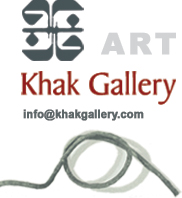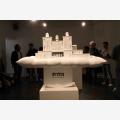
#1 Jila Alley, Basiri St. Gholhak
Shariati Ave. IRAN TEHRAN
TEL: (0098-21) 22 60 54 65
White Dreams ( فارسی )
SEND TO A FRIEND!Writen By By Roya Asaadian
Miniature buildings inhabited by tiny figurines are located on or wrapped in huge fiberglass pillows. Everything seems devoid of spirit, entirely plaster white. The figures walk on the buildings; the buildings swing, and pillows stretch like paste. Everything looks different in the world of Kambiz Sabri\\\\\'s sculptures.
Khak Gallery was host to the sculptures by Kambiz Sabri from 27 April to 16 May 2012. The sculptures are shown in three separate halls of the gallery: Two sculptures and a print in the main hall, and one sculpture in each of the other two rooms contained. This series can be considered as continuation of artist\\\\\'s play with three elements: human figure, architectural design, and pillow. Recurrence of these elements in Kambiz Sabri\\\\\'s work has made them a signature for the artist. Such recurrences free our mind from formal, shallow engagement, making it explore the invisible aspects of the subject.
Architectural representation in this series of works provokes nostalgic feelings. In the two works in the main hall, architectural models of \\\\\"Shamsol-Emareh\\\\\" mansion and \\\\\"Atisaz\\\\\" residential complex are elaborately represented, laid opposite each other. Confrontation of two buildings from two different eras evokes old and contemporary Tehran. Similarities might be detected in two buildings despite basic disparity: On the surface, the pure white color and fine, elaborate structure, and within deeper layers, formal similarities, including a recurrence of square forms and geometric structure.
The confrontation of the two buildings has certain connotations. The tallest building of its time, Shamsol-Emareh was a five-storied, 35-meter-high edifice built during the reign of Nassereddin Shah of the Qajar dynasty. Its top would provide a view to the entire old Tehran. From this perspective, Atisaz housing complex makes for a modern version of Shamsol-Emareh; while the landscape of Tehran that Nassereddin Shah achieved by ordering the construction of Shamsol-Emareh is now turned into a dull view of thousands of high-rise buildings.
At first sight, unusual foundations of these two works are arresting. The scale model of Shamsol-Emareh is leaning against a pillow which, in turn, is secured on a cubic form with a diagonal cross-section. The curve in the base and stretching pillow make the building swing like a cradle with the slightest touch. Swinging sculpture creates a sense of passage of time and, at the same time, signifies the transience and fragility of this old building. Modern and identical high-rise buildings of \\\\\"Atisaz\\\\\" are built upon thin, black pillars around which a pillow of blue sky is wrapped. Uprooting of the heavy building and imposition of its weight on a number of columns, produce a sense of suspension against the background of the blue pillow.
Human presence is of great significance in Sabri\\\\\'s work. Men in his work are small, identical architectural model figures submissively standing beside one another and completely authorized by their environment. In a majority of works in this series, men are either entrapped in glass cubes within the architectural structures or aimlessly standing together, facing same direction. Some seem spellbind, walking tidily in a thin line. Inside the glass cube, there are two facing mirrors, endlessly reflecting human figures as if in a never-ending nightmare. This is more evident in the figure in the middle. This work is a folded pillow within which a row of small figures is ensnared between the glass and mirror. Both ends of the pillow are folded to produce a form similar to traditional Iranian windows through which light passes. The curve of the pillow is stretched like soft paste.
If the scale of architecture and inhabitants is taken as a yardstick to perceive the work, the surrounding and underlying pillows assume gigantic, superhuman dimensions. When this soft mass embraces the building, we may conclude that a superhuman power has created the world. Such power that cannot draw from tiny figures entrapped in the works. It belongs to the artist, the creator of this world. An archetypal pillow is a one with perfect form, existing in its best condition, with least trace of outside impact. The artist, however, bends and sews the pillows, places them under the building, and paints them the same color as the sky. Through repeated use of pillow, Kambiz Sabri carries off its common function only to convey other meanings.
In the last part of the exhibition at the other end of the gallery, all doors and windows are painted black and a twisted, glossy pillow is fixed on the wall. There are two rows of pictures at the twisted end of the pillow. Both show close-up images of faces of girls and boys fixed inside a lightbox on the pillow after a 90-degree rotation. All eyes in the left-hand picture are shut as if those faces on the pillow are falling into a light sleep. In the other picture, though, gazing faces create the illusion of suddenly recognizing a space beyond the picture, being awakened by the presence of spectators.
The artist’s approach in the photograph on display in the first room is completely different from that of sculptures. It is, in fact, his elementary school diploma enlarged beyond its original dimensions and transposed on a board. We also see that both the name of the school and imperial government are crossed out and corrected with a black marker.
Throughout the journey to a different world along with Kambiz Sabri, we keep coming across a wide range of impossible things that seem to be rooted in our dreams. We are taken to a place, suspended between time and space; an unknown realm, no matter how familiar the elements are.

